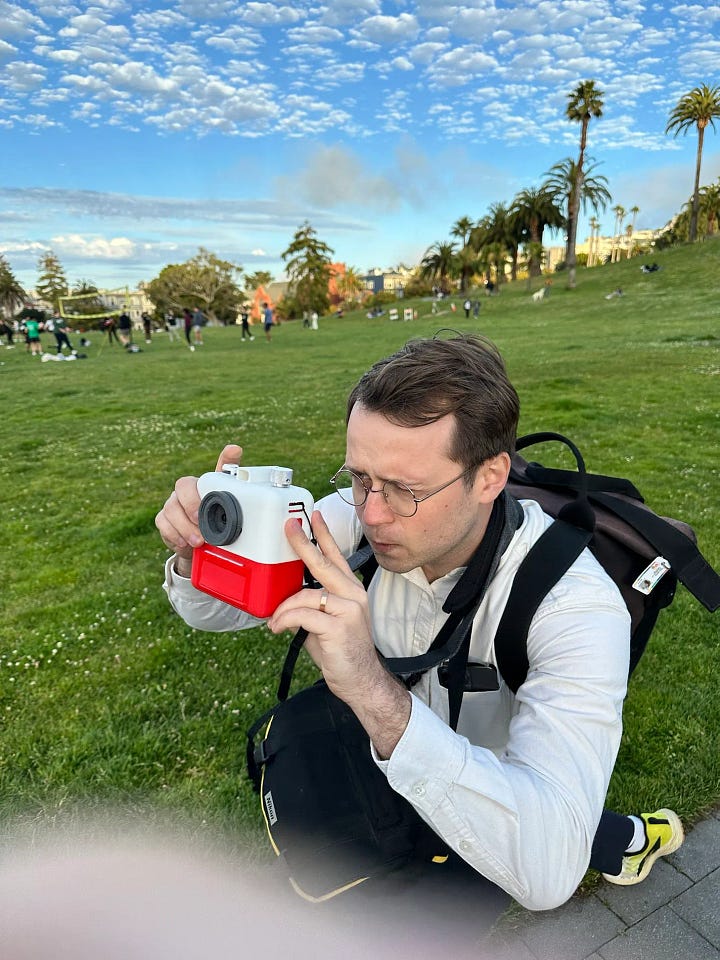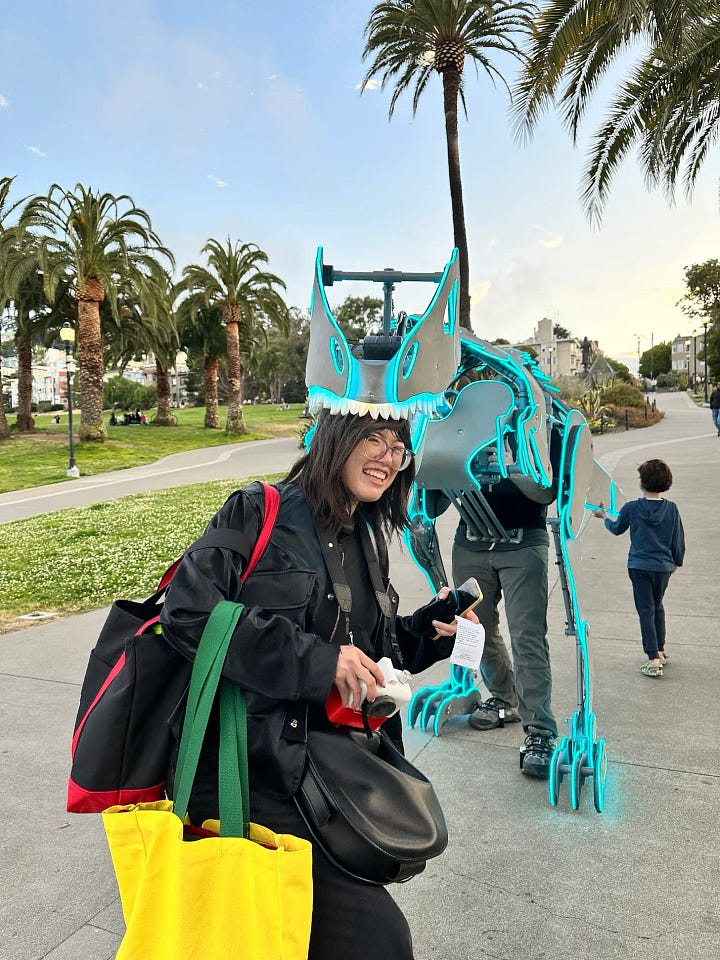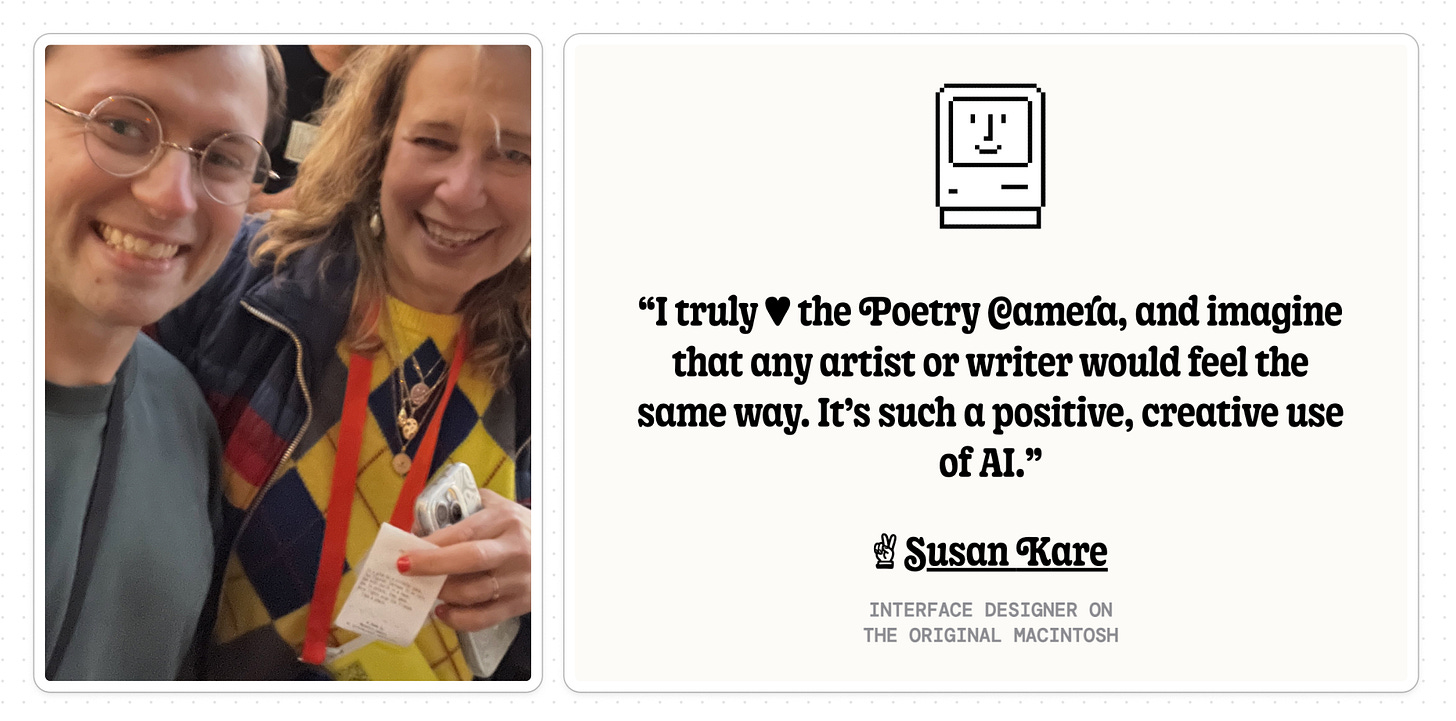v4 playtesting & when you can get v5
our first sale, photo walk in SF, v5 limited drop in the fall!
Updates from an eventful June
In our last newsletter, we described how we created the new v4 prototype of Poetry Camera. We just delivered two of them to our first ever customer, Atlantic Records! We’re grateful for their early support and enthusiasm.
We just got back from a trip to San Francisco, where we shared the v4 camera prototype with lots of friends old and new.

We hosted a Poetry Camera photo walk at Dolores Park in SF. We’d previously shared the camera at events run by other organizers, but this was the first one we hosted on our own. People took poem-photos, brought their own builds of the camera, and posed in fun new ways to see what the camera would write.








As always, there was some last-minute debugging as we encountered new bugs and failure modes, like burned-out wifi adapters and stray wire contact accidentally powering on the device.



And to top it all off, we met Susan Kare, one of the iconic interface designers on the original Macintosh, who loved Poetry Camera so much she let us quote her on our website.
“Ok that’s fine and all, but when can I get a camera of my own?”
That is, after all, why you signed up for this newsletter.
We’re preparing for a limited-edition drop (~20 units) in the fall.
We’re still figuring out the price, which will depend on our production costs, which will depend on our final design. Our goals are (1) to not lose money, (2) to make something we can be proud of, and (3) to have a lot of fun making it.
For the last few months, Ryan and I have been doing a lot of research into how to make this happen. We’ve been consulting with experts, reading books, listening to interviews… and the main lesson we’ve taken away is: whatever can go wrong, will go wrong — even if you’ve been doing this for a long time.
It’s easy to make a single prototype of an electronic device that works 80% of the time. The hard part is making many units that work 99% of the time.
Fun!
We currently have four Poetry Camera v4 prototypes in action — one for Ryan, one for me, and two for Atlantic Records. At best, each v4 unit takes three full days to create. This time includes 3D printing, assembly, and basic testing. There’s usually also reprints and component swaps and on-the-fly design changes if we’re putting together a new iteration. It worked for our needs at the time, since we optimized for whatever we could produce by ourselves.
Since we want to make more of these, we’re making some big changes to make it faster to produce and easier to assemble. In industry parlance, this is called DFA (design for assembly) and DFM (design for manufacturing). We basically want to make a small batch of a version that we could easily scale and support, if we decided to go down that path. To make this happen, we’ve started new work such as:
redesigning the enclosure to use fewer parts (so it’s easier to produce and assemble)
redesigning the enclosure for higher-scale, more polished production methods (certain methods, like injection molding, have very strict requirements for the shape)
porting the “brains” of the device from Raspberry Pi (a tiny computer used for prototyping) to a more production-ready, cost-effective, and widely-available component (like the ESP32 microcontroller, an industry-standard component for smart devices)
redesigning the power circuit to have longer battery life (v4 has 2 hours, which g
encapsulating all the new electronics in a custom PCB (printed circuit board) that we can quickly pop into each enclosure
creating polished and durable packaging that will protect the device in transit
Of course, we could just take 60 days to create 20 units of our past v4 prototype — but we’d still have to go through that list of changes above if we ever decided to make more than a few units, plus we’d have to juggle supporting both versions in the future. It seems like a much better use of our limited resources to make a single great version of Poetry Camera that’s much faster to produce. It might require more upfront work to develop, but would be much easier to support in the long run.
Plus, the work continues to be very fun.
We’re also planning a new feature for v5: customize your own Poetry Camera to write whatever you’d like. What would you make with it?
We envision three distinct ways of playing with Poetry Camera, so that there’s always new levels of camera behavior to unlock. It feels kind of like designing levels in a video game, if the game were a physical device.
Level 1: What will it write about this photo? Try taking photos of different poses, expressions, and objects to see how the camera reacts.
Level 2: Turn the knob on the camera to create different types of poems — from classic sonnets and haikus to more experimental formats like “Alliteration Mode,” where all words in the poem begin with the same letter. This gives you more control as you get more familiar with how the camera behaves.
Level 3 (new!): Customize the camera knob with your own ideas. We want to create a simple interface to let you update the knob so the camera can write whatever you tell it to write. You could invent a new poem format, or tell the camera to focus on particular themes, or even move beyond poems. Maybe we even let you swap in your own custom server and models, for those comfortable with programming.
So tell us, what ideas come to mind when it comes to customizing what the camera could write? How might you want to use this?
Replies go straight to our inboxes! We read each and every email :)
P.S. Live near the Hudson Valley? We’re having a photo walk at Ryan’s favorite local book store, Hudson Valley Books for Humanity. Check out the event and register here.






LOVE and can't wait and will buy. please send.
Awesome guys 😃👏🏼✨